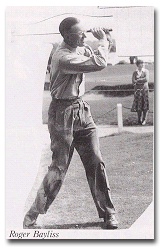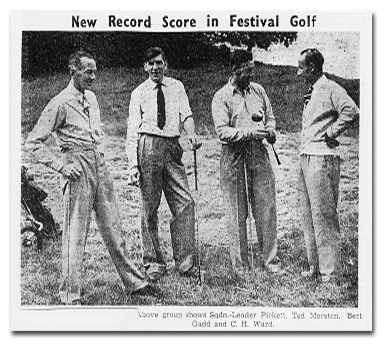|
 1951 was the year of the Festival of Britain and my old club,
Bridgnorth, arranged a match as part of the celebrations. The match
was to be two 18-hole medal rounds with a special prize for the
lowest score. I was invited to play along with my old buddy Charlie
Ward, who had just returned from finishing third behind Max Faulkner
in the Open at Royal Portrush. The other players involved were
Charlie Pickett, a Squadron Leader at RAF Bridgnorth; one of my
successors as club pro - Ted Morton and Roger Bayliss of South
Staffs, one of the best midland amateurs (and – like L. G. Crawley -
a very
accomplished ice skater), who had beaten me in the annual
Professional versus Amateurs match at Moortown in 1933. 1951 was the year of the Festival of Britain and my old club,
Bridgnorth, arranged a match as part of the celebrations. The match
was to be two 18-hole medal rounds with a special prize for the
lowest score. I was invited to play along with my old buddy Charlie
Ward, who had just returned from finishing third behind Max Faulkner
in the Open at Royal Portrush. The other players involved were
Charlie Pickett, a Squadron Leader at RAF Bridgnorth; one of my
successors as club pro - Ted Morton and Roger Bayliss of South
Staffs, one of the best midland amateurs (and – like L. G. Crawley -
a very
accomplished ice skater), who had beaten me in the annual
Professional versus Amateurs match at Moortown in 1933.
The course was still much as I had known it 20 years before, so I
had a distinct advantage. A course record 65 in the first round won
me the prize and I followed it with a second round 66 for good
measure. It was a happy return to a club for which I have a lot of
affection.
 I used my leave allowance for the
North British at Harrogate in 1951
and could not go to the Open at Royal Portrush, much as I would have
liked to return to the scene of my triumph in 1937. In any case,
although the first prize for the Open champion had now risen to
£300, the North British golf ball company were putting up £500. At
Portrush the champion was the man I had pipped to that Irish Open
title fourteen years earlier. Max Faulkner had signed a golf ball
for a youngster before the final round and, at the request of the
boy’s father, added - 1951 Open Champion. He said he had nightmares
about that for years, but his confidence was at its peak that week
and he had just played a shot that had put him on a ‘high’. His
drive had finished up against an out-of-bounds fence from where the
only shot seemed to be a wedge back to the fairway, but Max was not
a ‘percentage’ player. Out came the 3-wood and the ball was launched
over the fence and sliced back on to the green. His playing partner,
Frank Stranahan, said: “It was the greatest shot I have ever seen” I used my leave allowance for the
North British at Harrogate in 1951
and could not go to the Open at Royal Portrush, much as I would have
liked to return to the scene of my triumph in 1937. In any case,
although the first prize for the Open champion had now risen to
£300, the North British golf ball company were putting up £500. At
Portrush the champion was the man I had pipped to that Irish Open
title fourteen years earlier. Max Faulkner had signed a golf ball
for a youngster before the final round and, at the request of the
boy’s father, added - 1951 Open Champion. He said he had nightmares
about that for years, but his confidence was at its peak that week
and he had just played a shot that had put him on a ‘high’. His
drive had finished up against an out-of-bounds fence from where the
only shot seemed to be a wedge back to the fairway, but Max was not
a ‘percentage’ player. Out came the 3-wood and the ball was launched
over the fence and sliced back on to the green. His playing partner,
Frank Stranahan, said: “It was the greatest shot I have ever seen”
At Harrogate it seemed that the increased money was having an
adverse effect. The behaviour of some players was distinctly
unpleasant and I was dismayed at the decline in the standards on the
golf course that had been expected before the war. Times had changed
and not all for the better it seemed. It was twenty-eight years
since I had entered the paid ranks and, for the first time in my
life, I felt almost ashamed of being a professional. After I
returned from Harrogate I wrote in my column that one or two leading
professionals were becoming increasingly unpopular with golfing
spectators, due to childish displays of temper and an almost eager
readiness to condemn the course, its
condition, the general
arrangements – in fact anything except their own ability to cope
with prevailing conditions. After one of the early rounds on the
Pannal course a well-known pro of international fame was asked what
he had done. Although his score was in the low 70’s he apparently
was very dissatisfied and loudly proclaimed that he would like to
return and dig up the ‘so-and-so’ greens - a completely un-justified
criticism as the Pannal greens, although fast and tricky to putt on,
were very good indeed. At Oakdale, another famous player who had
failed to cope with the short but challenging course expressed the
opinion that the only time to play on this track was “when it was
under 2 ft of snow”. This once popular player had treated his
rapidly dwindling gallery to several outbursts of temper. They had
paid to see golf played, not an exhibition of bad temper, bad
manners and an utter lack of sportsmanship. Thankfully golf has
never had as many of these types as you find in football and some
other sports, but one is too many and it is sad to see a few of
today’s stars indulging in petulant behaviour when they are unable
to produce the figures when required.
NEXT |